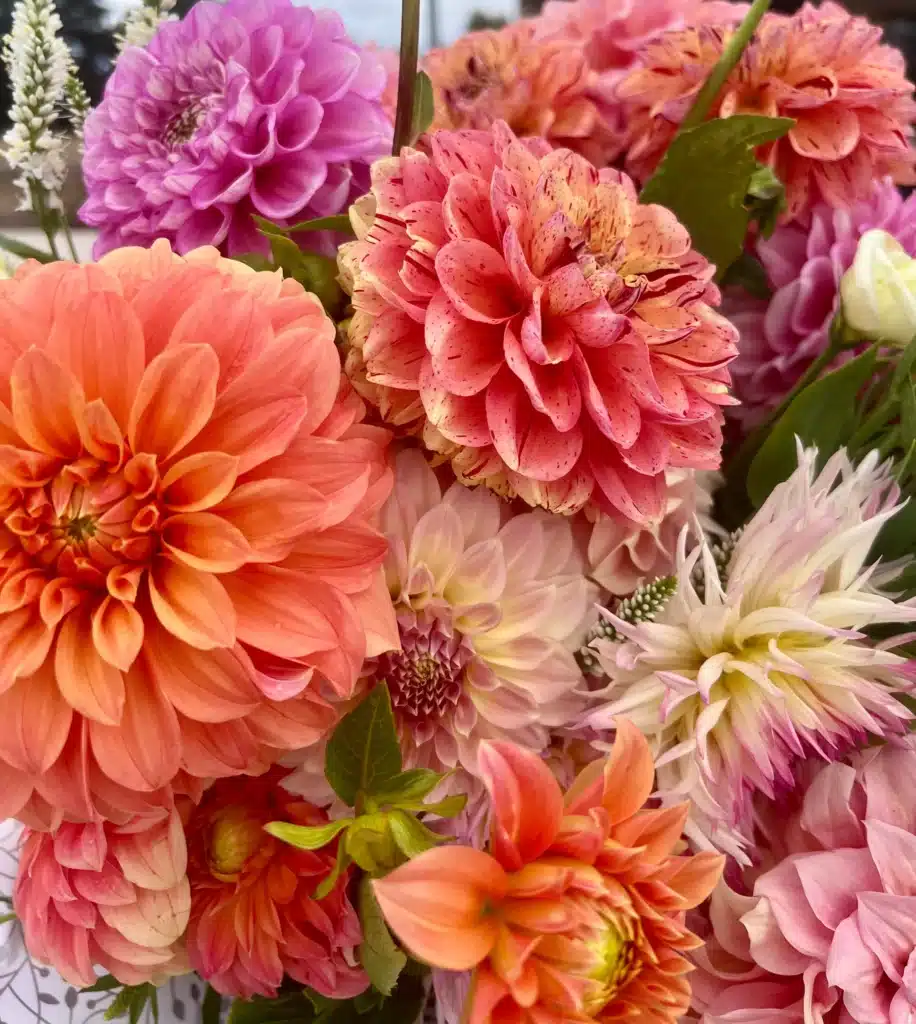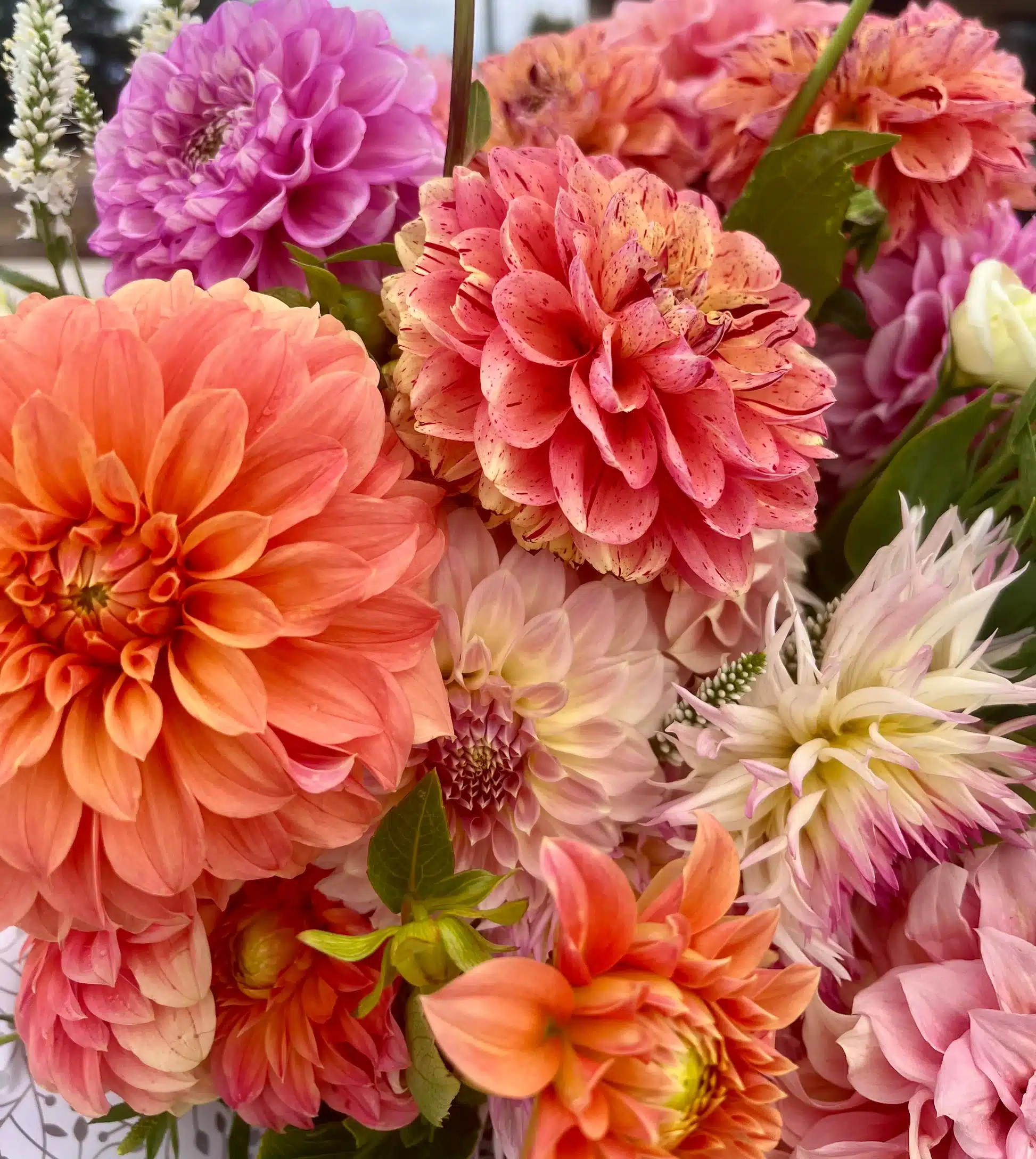
Dahlias are breathtakingly gorgeous flowers that come in every color of the rainbow. In South Africa, their tubers are best planted in early spring, usually around September to October, as soon as the danger of frost has passed. Learn more about planting, growing, and caring for dazzling dahlia flowers below. Buy dahlias at Grow Folk
About Dahlia Flowers
Picking a favorite dahlia is like going through a button box! The flowers can range in size from petite 5 cm lollipop-style pompoms to giant 38 cm “dinner plates.” Most varieties grow 1.2 to 1.5 meters tall. Dahlias are available in a wide range of beautiful colors, including white, yellow, orange, pink, dark pink, red, dark red, lavender, purple, black, light blend, bronze, flame, dark blend, variegated, and bicolor!
Dahlia is a genus of tuberous plants that are members of the Asteraceae family. The tubers are planted in early spring (around September to October in South Africa) and generally flower from December to the first autumn frosts (usually around April to May). Dahlias are perfect for a border garden and make lovely cut flowers. Growing vegetables? Put a row of dahlias on the border, where they will not shade your edibles.
Are Dahlias Perennials or Annuals?
Dahlias are tender perennials in their native warm climate of Mexico. In South Africa, they are generally treated as perennials in frost-free areas or as annuals in colder regions. In frost-prone areas, dahlias should be dug up after the first frost and stored in a cool, dry place until the next planting season.
When to Plant Dahlias
Dahlias will not tolerate cold soil. Plant when the soil reaches 15°C and any danger of frost has passed (usually around September to October in South Africa). Planting dahlias a few days after tomatoes are planted in the ground is a good rule of thumb. Some gardeners start tubers indoors in containers a month ahead to get a jump on the season.
How to Plant Dahlias
- Avoid planting dahlia tubers that appear wrinkled or rotten. Pink “eyes” (buds) or a little green growth are good signs.
- Plant large dahlias in a dedicated plot where they will be free from competition from other plants. Set tubers in rows spaced 90 cm apart. If you plant dahlias about 30 cm apart, they make an excellent flowering hedge and will support each other.
- Plant medium- to low-height dahlias, usually in the 90 cm tall range, among other summer flowers. Set them 60 cm apart.
- Start by digging a 15 to 20 cm deep hole to plant the tubers. It helps to mix some compost and a handful of bonemeal into the planting hole. Do not fertilize at planting.
Set a tuber into the hole with the growing points, or “eyes,” facing up. Cover the tuber with 5 to 8 cm of soil. As the stem sprouts, fill in with soil until it is at ground level. Do not water the tubers right after planting. Wait until the sprouts have appeared above the soil before watering.
Growing Dahlias in Containers
Medium- to dwarf-size dahlias do well in containers with drainage and are big enough to support the plant at maturity. Generally, a 30×30 cm container will suffice.
Use a soilless mix and co-polymer moisture-retaining crystals, per the package’s guidance. Cover the tuber with a few centimeters of soil-crystal mix and spray water on the tuber, if necessary, until growth starts. Do not water if the soil is damp 2.5 cm below the surface. Fertilize through summer as directed and add soil if the roots become exposed.
Growing Tips
- When dahlias are established, water 2 or 3 times a week, increasing in hot, dry conditions.
- After sprouting, dahlias benefit from a low-nitrogen, liquid fertilizer every 3 to 4 weeks from midsummer until early autumn.
- Pinch out the center branch when plants are about 30 cm tall to encourage bushier growth.
- Deadhead fading flowers to encourage more blooms.
Harvesting
The more you cut dahlias, the more they’ll bloom! For a bouquet, cut stems in the morning before the heat of the day and place them into a bucket of cool water. Remove the stems’ bottom leaves and place the flowers into a vase of water.
Digging Up and Storing Dahlia Tubers
Dahlia foliage blackens with the first frost. Take it as a warning to begin digging up the tubers. Complete the task before a hard frost:
- Cut off blackened foliage, leaving 5 to 10 cm of top growth.
- Dig around tubers carefully with a pitchfork or shovel.
- Lift the clump and gently shake off the soil.
- Pack tubers in loose, fluffy material (e.g., vermiculite, dry sand) and store in a well-ventilated, frost-free space: 5 to 10°C is ideal.
Readying for Summer
In spring (around August to September), separate healthy tubers from the parent clump and discard wrinkled or rotten ones. Each tuber must have at least one “eye” or piece of the crown attached, or it will not develop into a blooming plant.
Pests and Diseases
Watch out for common dahlia pests like aphids, caterpillars, earwigs, slugs, snails, and spider mites, as well as diseases like Botrytis blight, powdery mildew, and wilt.
Dahlias are a beautiful addition to any South African garden, offering vibrant colors and varieties to suit every taste!



